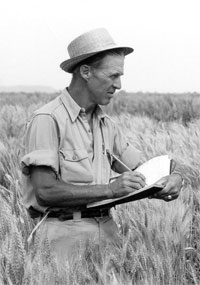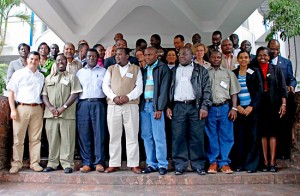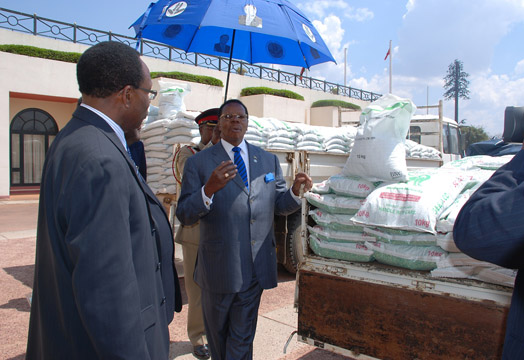 CIMMYT joins with members of the international development community to mourn the passing of Nobel Peace Laureate and renowned wheat scientist, Dr. Norman E. Borlaug, who died Saturday night at the age of 95 from complications from cancer, after an exemplary life dedicated to fighting hunger in developing countries.
CIMMYT joins with members of the international development community to mourn the passing of Nobel Peace Laureate and renowned wheat scientist, Dr. Norman E. Borlaug, who died Saturday night at the age of 95 from complications from cancer, after an exemplary life dedicated to fighting hunger in developing countries.
Dr. Borlaug worked as a CIMMYT wheat breeder and research director for nearly four decades and was a CIMMYT scientist at the time he received the Nobel Peace Prize.
High-yielding wheat varieties and improved farming practices, first developed by Borlaug and his team in Mexico during the 1950s, were introduced into South Asia in the 1960s and may well be responsible for saving hundreds of millions of people from starvation. Known as the Green Revolution, Borlaug’s work gave rise to science-based agriculture in developing countries. Today, high-yielding, disease-resistant wheat varieties based on Dr. Borlaug’s pioneering work are grown on 80 million hectares (200 million acres) throughout the world.
Borlaug received the 1970 Nobel Prize for those achievements, and his success led to the establishment of a network of 15 international agricultural research centers, including CIMMYT.
Borlaug’s full-time employment at CIMMYT ended in 1979, although he remained a resident part-time consultant until his death. In 1984, he began a new career as a university professor, teaching one semester a year at Texas A&M University, which continued for 23 years. In 1986, he joined forces with former U.S. President Jimmy Carter and the Nippon Foundation of Japan, under the chairmanship of Ryoichi Sasakawa, to develop an African agricultural initiative. Over a 20-year period, the Sasakawa-Global 2000 agricultural program, as it is known, has been working in 15 African countries to transfer improved agricultural technology to several million small-scale farmers.
Borlaug was especially proud of his role in establishing the World Food Prize in 1986. This prize has grown in stature and is now considered the “Nobel Prize” for food and agriculture. Some 25 men and women have been recognized for their outstanding contributions to increasing the quantity, quality and availability of world food supplies. Based in Des Moines, Iowa, the World Food Prize Foundation has also developed outstanding educational programs to engage young people in world food issues.
Dr. Borlaug always considered himself to be a teacher, as well as a scientist. Today, several thousand men and women agricultural scientists from more than 50 countries are proud to say they were Norman Borlaug’s “students.”
Borlaug used his fame and influence to champion the cause of smallholder agricultural development around the globe. Over a 63-year career, he traveled tirelessly to more than 100 nations, visiting farmers and agricultural scientists in their fields. It is estimated that over his lifetime he personally spoke to more than 500,000 students and ordinary citizens, explaining the challenges and complexities of world food production.
Borlaug was voted a member of the academies of agricultural science of 11 nations, received 60 honorary doctorate degrees from those countries, and was honored by farmer and civic associations in 28 countries.
Of all the places that he visited, his beloved home was Mexico, and in particular, the irrigated Yaqui Valley in the state of Sonora, in northwest Mexico. “This is where I truly feel at home, and where I am at peace,” he would often say. The feeling was reciprocal. In Ciudad Obregón, in the heart of the Yaqui Valley, one of main streets is named after Borlaug, and hundreds have known him since they were born.
Although probably better known outside the United States—in Mexico, India, Pakistan, China and Latin America, Borlaug’s work has also been widely recognized in the USA. At the federal level, he received the Presidential Medal of Freedom, the National Medal of Science and the Congressional Gold Medal, the nation’s highest civilian award.
CIMMYT was also home to Dr. Borlaug, who was known as a simple and charismatic figure, who spoke Spanish fluently and truly cared about people, greeting and chatting with researchers and field workers alike. His dedicated pragmatism and vision of applying science to benefit the poor live on as core values of CIMMYT and several other institutions with which he was closely associated.
Norm, as he liked be called, lived his life as a dedicated hunger-fighter, but one who was forever vigilant. As he said in his acceptance speech of the 1970 Nobel Prize: “…It is true that the tide of the battle against hunger has changed for the better…but ebb tide could soon set in, if we become complacent…”
![]() We can think of no greater tribute to Norm than to carry on the work to which he dedicated his life: applying agricultural science for humanitarian benefits. Thus, he lives on in our hearts and, through our efforts, the work he began will also live on.
We can think of no greater tribute to Norm than to carry on the work to which he dedicated his life: applying agricultural science for humanitarian benefits. Thus, he lives on in our hearts and, through our efforts, the work he began will also live on.
“Today we stand bereft of Borlaug’s physical presence, but not of his spirit or ideals,” says Thomas A. Lumpkin, CIMMYT Director General. “Norm once said: ‘I personally cannot live comfortably in the midst of abject hunger and poverty and human misery.’ Millions of small-scale farmers in developing countries today still practice low-input, subsistence agriculture, condemning them and their families to lives of poverty. They typically spend at least 70% of their income on food, and most are at risk of being malnourished. The world cannot be at peace until these people are helped to feed themselves and escape poverty.”
The CIMMYT family extends its condolences to the Borlaug family, who live in Texas, California and Iowa. He is survived by his son Bill, his daughter Norma Jean, five grandchildren, and several great grandchildren.
 A workshop on media handling and science communication was held for spokespersons of the
A workshop on media handling and science communication was held for spokespersons of the  Malawi’s President Bingu wa Mutharika hosted CIMMYT’s Wilfred Mwangi, project leader of Drought Tolerant Maize for Africa (DTMA), and Peter Setimela, maize breeder, at the State House in Lilongwe. The two briefed him on CIMMYT’s maize research activities and collaboration in Malawi, which date back to 1974. “The new maize variety, ZM 309, released under the auspices of the DTMA Project, will give Malawi farmers an advantage because it is high yielding and drought tolerant,” said President Bingu wa Mutharika on receiving a 10-ton consignment of ZM 309 seed presented by Mwangi and Setimela on behalf of CIMMYT. “We welcome this research because it will help Malawi cope with climate change and improve food security.”
Malawi’s President Bingu wa Mutharika hosted CIMMYT’s Wilfred Mwangi, project leader of Drought Tolerant Maize for Africa (DTMA), and Peter Setimela, maize breeder, at the State House in Lilongwe. The two briefed him on CIMMYT’s maize research activities and collaboration in Malawi, which date back to 1974. “The new maize variety, ZM 309, released under the auspices of the DTMA Project, will give Malawi farmers an advantage because it is high yielding and drought tolerant,” said President Bingu wa Mutharika on receiving a 10-ton consignment of ZM 309 seed presented by Mwangi and Setimela on behalf of CIMMYT. “We welcome this research because it will help Malawi cope with climate change and improve food security.” CIMMYT joins with members of the international development community to mourn the passing of Nobel Peace Laureate and renowned wheat scientist, Dr. Norman E. Borlaug, who died Saturday night at the age of 95 from complications from cancer, after an exemplary life dedicated to fighting hunger in developing countries.
CIMMYT joins with members of the international development community to mourn the passing of Nobel Peace Laureate and renowned wheat scientist, Dr. Norman E. Borlaug, who died Saturday night at the age of 95 from complications from cancer, after an exemplary life dedicated to fighting hunger in developing countries.